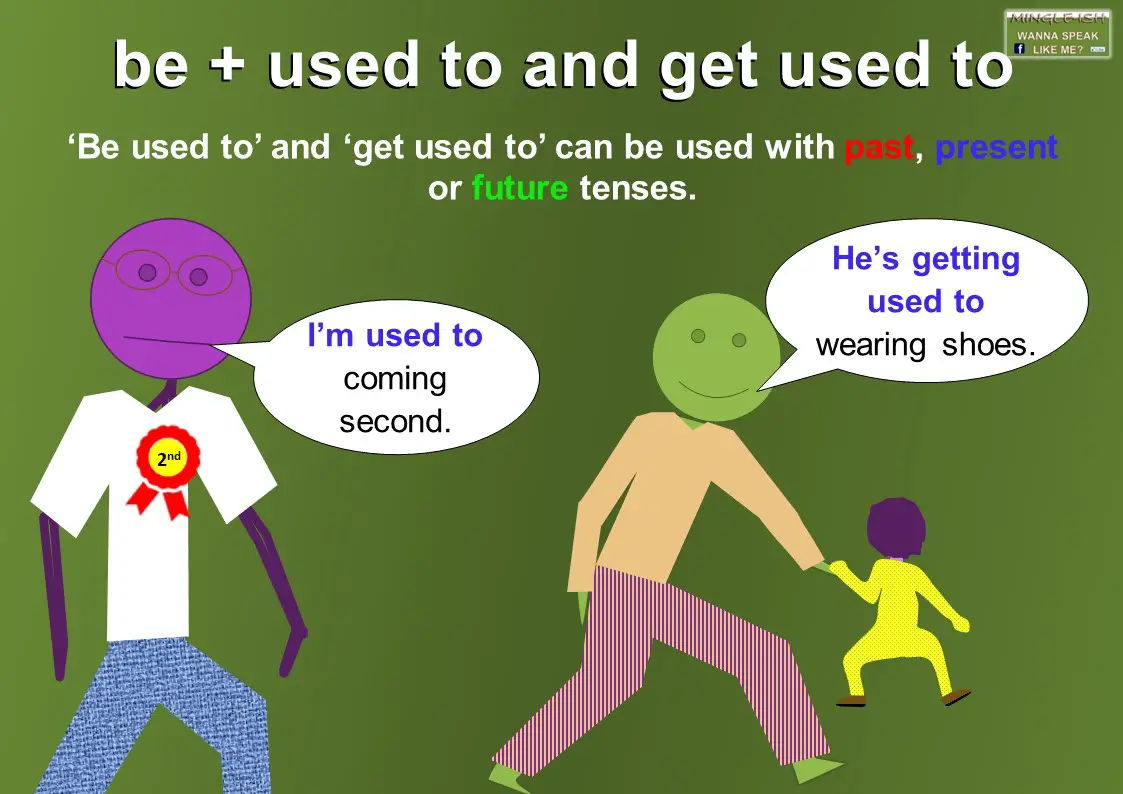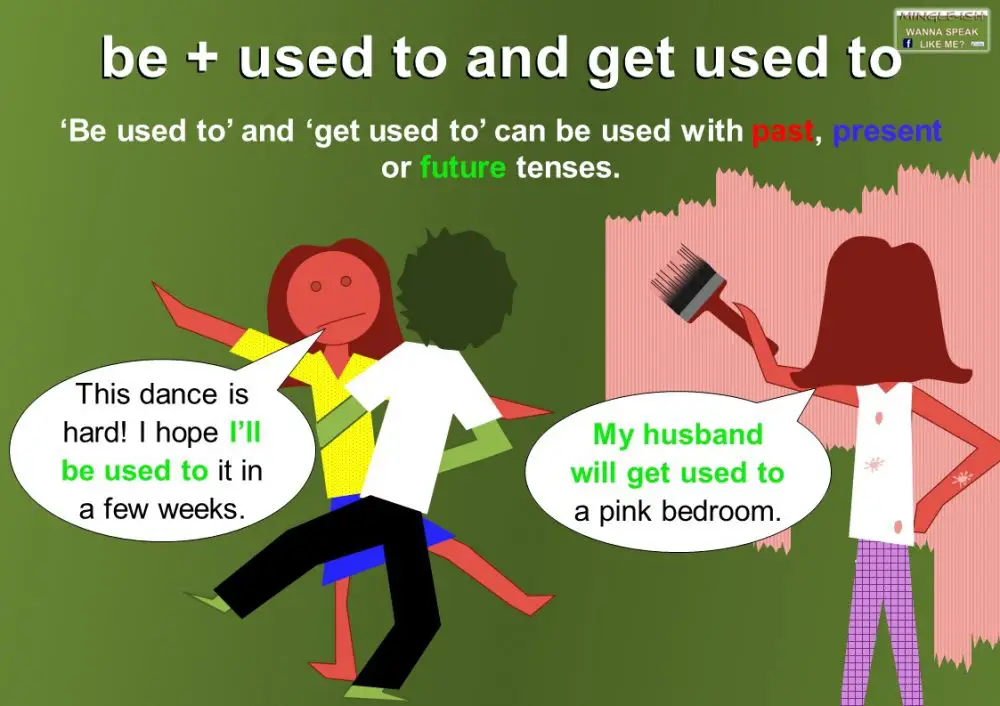Be Used To Get Used To

Capita a tutti: ti imbatti in una frase in inglese che sembra quasi corretta, ma ti lascia con un senso di confusione. "Be used to" e "Get used to" sono due di queste espressioni. Sembrano simili, ma usandole in modo errato puoi ritrovarti a dire qualcosa di completamente diverso da quello che intendevi! Sei stanco di fare questi errori?
Questo articolo ti guiderà attraverso le insidie di "be used to" e "get used to", spiegandoti le differenze fondamentali e fornendoti esempi pratici per usarle correttamente. Dimentica la frustrazione, abbraccia la chiarezza!
"Be Used To": Abitudine e Familiarità
L'espressione "be used to" indica una situazione abituale, qualcosa a cui sei abituato, che ti è familiare. Significa che ti senti a tuo agio con una certa attività, situazione o persona perché la sperimenti regolarmente.
La struttura è semplice: Soggetto + be (am/is/are/was/were) + used to + sostantivo/gerundio (-ing form)
Esempi per chiarire:
- I am used to waking up early. (Sono abituato ad alzarmi presto.)
- She is used to living in a big city. (Lei è abituata a vivere in una grande città.)
- They were used to eating spicy food. (Erano abituati a mangiare cibo piccante.)
Nota che dopo "used to" usiamo un sostantivo (es. "waking up") o un gerundio (es. "spicy food"). L'importante è che si riferisca a qualcosa di cui hai esperienza, a cui sei acclimatato.
Considera questa statistica: secondo uno studio condotto dall'Università di Cambridge, gli studenti che studiano all'estero e si "abituano" (get used to) a una nuova cultura, dimostrano una maggiore resilienza e adattabilità a lungo termine. Questo sottolinea l'importanza dell'abitudine e della familiarità nel nostro sviluppo personale.
Utilizzo di "Be Used To" al Negativo e Interrogativo
Possiamo formare frasi negative e interrogative con "be used to" seguendo le regole grammaticali del verbo essere:
- Negativo: Soggetto + be + not + used to + sostantivo/gerundio
- I am not used to driving on the left. (Non sono abituato a guidare a sinistra.)
- She isn't used to the cold weather. (Lei non è abituata al freddo.)
- Interrogativo: Be + Soggetto + used to + sostantivo/gerundio?
- Are you used to working late? (Sei abituato a lavorare fino a tardi?)
- Was he used to living alone? (Era abituato a vivere da solo?)
Presta attenzione all'ordine delle parole. La negazione si forma con "not" dopo il verbo "essere", e la domanda si forma invertendo l'ordine del soggetto e del verbo "essere".
"Get Used To": Adattamento e Acclimatamento
"Get used to" esprime il processo di adattamento a qualcosa di nuovo, il diventare abituati. Implica un cambiamento, un passaggio da una situazione sconosciuta o scomoda a una situazione familiare e confortevole.
La struttura è: Soggetto + get (get/gets/got/getting) + used to + sostantivo/gerundio (-ing form)
Esempi per illustrare:
- I am getting used to the noise. (Mi sto abituando al rumore.) (Implica che il rumore era inizialmente fastidioso, ma sto iniziando ad accettarlo.)
- He got used to his new job very quickly. (Si è abituato molto velocemente al suo nuovo lavoro.) (Implica che il nuovo lavoro inizialmente richiedeva un periodo di adattamento.)
- She will get used to the different culture. (Si abituerà alla cultura diversa.) (Implica che il processo di adattamento è in corso o futuro.)
Anche in questo caso, dopo "used to" utilizziamo un sostantivo o un gerundio. La differenza chiave è che "get used to" si concentra sull'azione di diventare abituati.
Un recente studio psicologico ha dimostrato che le persone che intraprendono attivamente azioni per "abituarsi" (get used to) a un cambiamento (es. imparare la lingua locale quando si trasferiscono in un nuovo paese) hanno maggiori probabilità di integrarsi con successo e sperimentare una maggiore felicità. Questo evidenzia l'importanza dell'azione e dell'impegno nel processo di adattamento.
Utilizzo di "Get Used To" al Negativo e Interrogativo
La formazione di frasi negative e interrogative con "get used to" segue le regole grammaticali dei verbi regolari al presente e al passato:
- Negativo: Soggetto + do/does/did + not + get used to + sostantivo/gerundio
- I don't get used to the cold easily. (Non mi abituo facilmente al freddo.)
- He didn't get used to living in the countryside. (Non si è abituato a vivere in campagna.)
- Interrogativo: Do/Does/Did + Soggetto + get used to + sostantivo/gerundio?
- Do you get used to public speaking? (Ti abitui a parlare in pubblico?)
- Did she get used to the new system? (Si è abituata al nuovo sistema?)
Utilizziamo gli ausiliari "do", "does" e "did" per formare negazioni e domande. È fondamentale non dimenticare questi ausiliari per evitare errori grammaticali.
La Differenza Chiave: Stato vs. Processo
La differenza principale tra "be used to" e "get used to" risiede nella loro natura:
- "Be used to" descrive uno stato: indica che sei già abituato a qualcosa. È una condizione esistente.
- "Get used to" descrive un processo: indica che ti stai adattando a qualcosa, che stai diventando abituato. È un'azione in corso o un cambiamento nel tempo.
Pensa a un esempio pratico: se vivi in una città rumorosa da anni, puoi dire "I am used to the noise". Se invece ti sei trasferito da poco in una città rumorosa, puoi dire "I am getting used to the noise".
Errori Comuni da Evitare
Ecco alcuni errori comuni che gli studenti di inglese commettono con "be used to" e "get used to":
- Confondere le strutture: Usare "get used to" quando si intende descrivere uno stato di abitudine già acquisito, o viceversa. Errore: "I get used to waking up early" (invece di "I am used to waking up early").
- Omettere il verbo "essere" con "be used to": Errore: "I used to waking up early".
- Non usare il gerundio o un sostantivo dopo "used to": Errore: "I am used to wake up early" (invece di "I am used to waking up early").
- Dimenticare gli ausiliari nelle negazioni e domande con "get used to": Errore: "I not get used to the cold".
Prenditi il tempo per rivedere la struttura corretta e gli esempi forniti in questo articolo. La pratica rende perfetti!
Consigli Pratici per Padronizzare "Be Used To" e "Get Used To"
Ecco alcuni consigli pratici per aiutarti a padroneggiare l'uso di "be used to" e "get used to":
- Esercitati con esempi reali: Scrivi frasi che descrivono la tua vita, le tue abitudini e i tuoi processi di adattamento.
- Ascolta attentamente: Presta attenzione a come i madrelingua usano queste espressioni in conversazioni, film e serie TV.
- Leggi in inglese: Osserva come gli scrittori usano "be used to" e "get used to" in contesti diversi.
- Chiedi feedback: Fai controllare i tuoi esercizi da un insegnante o da un madrelingua.
- Non aver paura di sbagliare: L'errore è una parte naturale del processo di apprendimento. Impara dai tuoi errori e continua a praticare.
Un esercizio utile: Pensa a tre cose a cui sei già abituato (be used to) e tre cose a cui ti stai attualmente abituando (get used to). Scrivi le frasi e rileggile ad alta voce. Questo ti aiuterà a memorizzare le strutture e a interiorizzare le differenze.
Ad esempio:
- I am used to drinking coffee every morning.
- I am used to commuting to work by train.
- I am used to the Italian lifestyle.
- I am getting used to the new software at work.
- I am getting used to waking up earlier.
- I am getting used to speaking Italian more fluently.
Ricorda, la chiave è la pratica costante e la consapevolezza delle differenze sottili tra queste due espressioni. Con un po' di impegno, sarai in grado di usarle con sicurezza e precisione.
Quindi, la prossima volta che ti imbatterai in "be used to" o "get used to", non farti prendere dal panico! Ricorda la distinzione tra stato e processo, esercitati con esempi reali e, soprattutto, divertiti ad imparare l'inglese! Buona fortuna!








